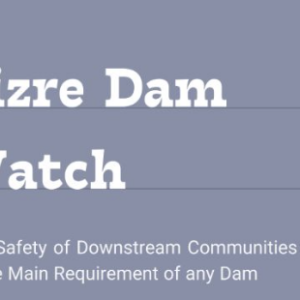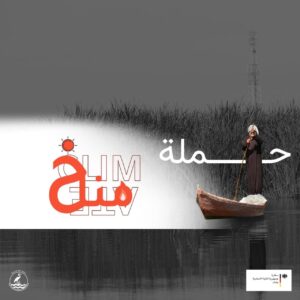By Alexandra Marvar – The Nation, 11 November 2019
In times of conflict, war, and climate change, hydropower is state power
Since the early 2000s, a massive hydropower project in southeastern Turkey has been mired in controversy, moving forward in fits and starts. But as of this past July, construction is finally complete. As the dam and its reservoir become fully operational, the line between hydropower and state power will be washed away. This fall, the violence that followed a sudden, destabilizing withdrawal of US troops from nearby northern Syria captured the world’s attention as it cleared the path for Turkey’s military to dominate the Kurdish opposition.
Meanwhile, the water slowly rising behind the 442-foot-high, more-than-a-mile-wide wall of the Ilisu Dam across the Tigris River is a less overt sign of that same determination.
“This dam is a weapon against the lowlands,” said Ulrich Eichelmann, a German ecologist and conservationist and head of the Austrian NGO RiverWatch, over the phone from Vienna. “It was planned and is now being built in a way they can hold back the whole Tigris for a long time. If you see water as a weapon, dams are the new cannons. Iraq has the oil, Turkey has the water, and sometimes, it’s much better to have the water.”
The Tigris and Euphrates rivers, two of the three longest rivers in the Middle East after the Nile, both originate in Turkey. The Euphrates flows across Turkey, south through the heart of Syria, and into Iraq. Now, both of these storied, sacred, ancient rivers are drying up, and the (once) Fertile Crescent is giving way to arid, cracked ground.
To some extent, the culprit is climate change. More immediately, the fate and exploitation of these rivers lies with Turkey’s hydropower development and the 41-component project of which the Ilisu Dam is just one part: Dams on the Euphrates have reduced water flow into Syria by an estimated 40 percent in the past 40 years and into Iraq by nearly twice that. With the damming of the Tigris, the last lifeline to this region will also be in Turkey’s grip.
Downriver, the effects will be water shortage. The Mesopotamian Marshes in Iraq may turn to desert. This region, now a UNESCO World Heritage site, was drained during the Iran-Iraq War of 1980 and again by Saddam Hussein in a tactical maneuver to expose his enemies. After Hussein’s ouster, the dikes he had built were torn down in celebration, and the parts of the marshland ecosystem began to return to its previous, verdant state. With the Ilisu’s restricted water flow will come not only ecological repercussions but also a tactical advantage for enemies of the region’s inhabitants.
Upriver, the problem will be not too little water but an inundation. As with the creation of any major reservoir, bird and fish habitats will be wiped out and the regional climate will be altered. Ecosystems, residential areas, and archaeological sites will be submerged.
For the past few years, though, one loss has loomed particularly large: the 12,000-year-old settlement of Hasankeyf, a Kurdish heritage site with untold archaeological value, soon to be inundated by Ilisu’s artificial lake.
In the context of Turkey’s history of imperialism against the Kurds, the impact of this dam-building spree extends well beyond Kurdish Turkey to the entirety of Syria and Iraq. From there, the geopolitical repercussions ripple outward. More than progress, Ilisu is a play for power and domination.
After World War I, the Ottoman Empire broke into pieces. One became independently ruled Turkey; others were divided among Western superpowers, who made a provision to the Kurds—indigenous peoples of the stretch of Mesopotamia that stretches across parts of Turkey, Syria, Iraq, Iran, and Armenia—for an independent Kurdistan.
But when the boundaries of modern-day Turkey were drawn shortly thereafter in 1923, that provision was left out. The Kurds, now the minority in every country they inhabit, have been fighting for their homeland ever since. Violent friction between Kurdish separatist groups and Turkey over this question is ongoing.
As early as the 1930s, the new Turkish nation under founder Mustafa Kemal Atatürk began to explore how its rivers and the Euphrates in particular could be harnessed for power generation. A proposal for the eventual Southern Anatolia Project—Güneydo?u Anadolu Projesi, or GAP—was floated as early as the 1960s. Today, GAP consists of 22 dams—including Ilisu and, on the Euphrates, Atatürk—and the hydroelectric infrastructure to support them.
Turkey put the first of GAP’s dams on the Euphrates into use in 1974, gaining new control over the water supply to Kurdish, Syrian, and Iraqi neighbors downriver. That same year, the Kurdistan Workers Party (PKK, the militant separatist organization that tends to frame most discussion about contemporary Kurdish-Turkish relations) was founded.
In step with the Keban Dam, Syria opened its own dam on the Euphrates, the Tehba, for which planning had been underway in partnership with the Soviet Union since the late 1950s. The combined effect of Turkey’s and Syria’s two dams on the Euphrates sent Iraq into a devastating drought, bringing Iraq and Syria to the brink of war.
After successfully pitting its neighbors against each other, Turkey entered into an interim water protocol accord with Iraq in 1984 and one with Syria in 1987, early in the PKK’s full-scale insurgency. In the Syrian agreement, Turkey guaranteed a set minimum annual flow from the Euphrates basin into Syria. Further down the page, Syria vowed to end PKK activities on Syrian soil: a vivid quid pro quo.
In the early 1990s, the Turkish government completed the Atatürk Dam—the fourth-largest dam in the world—causing the forced resettlement of upwards of 50,000 people in a predominantly Kurdish region. It demolished the ancient city of Samosata, an ancient Hellenistic and then Roman capital and birthplace of ancient Greek poet Lucian, as well as Neval? Çori, a Neolithic settlement where, in the little time they had, archaeologists discovered some of the world’s oldest known temples and monuments. In filling the Atatürk reservoir, Turkey cut off the majority of the Euphrates’s flow into Syria and Iraq for weeks, crippling agriculture. In virtually the same moment, then-President Turgut Özal asked Syria and Iraq to help combat the PKK.
In the decades that followed, Kurdish-Turkish relations continued to deteriorate; democracy under President Erdo?an continued to backslide; and Turkey’s grip on its neighbors’ fate through control of water only tightened, bringing drought to once-fertile Syrian and Iraqi farmlands, drying up entire villages, and forcing people to relocation to cities In 2009, Turkey responded to an election victory for the pro-Kurdish Democratic Society Party (DTP) with hundreds of arrests and detainments of DTP members. That same year, Syria was in the midst of a five-year drought and desperate for Turkey to relinquish more water resources.
Syria was of no great use in tempering opposition from the PKK, and—possibly in response—Turkey refused to come to Syria’s aid in the water crisis. The mounting unrest that followed ultimately created the political and social volatility that led to Syria’s 2010 Arab Spring. In 2018, The New York Times reported that the Euphrates, surrounded by parched land and depopulated villages, serves as a barrier between American-backed Kurdish-led militias and Turkish-backed rebels. It was this area that fell into chaos with Trump’s October withdrawal of American troops.
The Turkish government has stood by the Ilisu project as a means of development and progress in Southern Anatolia. The Turks argue that since the $2 billion dam will generate a projected 2 percent of the national energy budget—enough electricity to power well over a million homes—the displacement of 80,000 people over 125 square miles doesn’t seem significant enough to alter a plan that has been decades in the works. It also claims the project will aid a transition to carbon-neutral power (if one disregards the carbon footprint of constructing a mile-long wall of rock and steel over the course of decades), is rife with new opportunities from irrigation to tourism, and that regulation of water flow into drought-plagued Syria and Iraq could bring the benefit of year-round consistency.
But experts aren’t buying it. Ercan Ayboga is an environmental engineer and a spokesperson for Keep Hasankeyf Alive, a Kurdish-led NGO advocating for the preservation of Hasankeyf and other at-risk sites in the future Ilisu basin. Of course, the project will generate some electricity, he said over the phone from his home in Germany. At its core, though, he sees the dam as a tool to facilitate the assimilation of Kurdish people into Turkish society, forcing them into cities where their communities and culture will be more diffuse. “Today, [Ilisu] is a tool to use against the Kurdish guerilla,” he says. “Tomorrow it could be used against something different—against any form of opposition.”
The loss of a priceless world heritage site at Hasankeyf was the argument on which the project might have been halted in its tracks. Continuously inhabited for more than 10 millennia by the Byzantines, Romans, Mongols, Ottomans, and, for centuries, the Kurds, these civilizations artifacts and architecture all layered upon each other—ancient cave dwellings, amphitheaters, aqueducts, mosques, minarets—Hasankeyf could easily have fulfilled the necessary five of 10 criteria to become a UNESCO World Heritage Site. Some experts say, in fact, it meets nine of the 10. But the organization couldn’t intervene to stop the flood because, it said, Turkey never applied for the inclusion of the ancient city of Hasankeyf on the World Heritage List.
If Hasankeyf could not offer leverage to stop the Turkish government, the UNESCO-protected Mesopotamian Marshes, which experts say will wither and desertify as a result of Ilisu, may have offered another chance. But Iraq, beholden to Turkey by hydropolitics, was unwilling to advocate for the marshlands (and the Marsh Arabs to whom they are home)—it could mean retribution in the form of water deprivation via any of the number of existing dams on the Turkish-Iraqi border. And more dams on this border are already in the works.
Through the relocation and subsequent cultural assimilation resulting from this development, water policy has helped the Turkish government exercise direct control over the Kurds in Turkey, and by controlling water flow to Iraq and Syria, indirect control over a much larger part of the Kurdish nation.
According to data from 2016, 11 GAP dams are currently operational, and at least three are under construction. PKK separatists desperate to keep control of the water out of Turkey’s hands have bombed the construction sites of some of the new dams, prolonging the building phase, but development moves forward.
In Hasankeyf, a barricade blocks the entry of outsiders, and Ayboga reported that the process of relocating its residents—slated for completion earlier this month—has been slow, unclear, and disorganized, leaving hundreds with nowhere to go as the water approaches.
NGOs like Keep Hasankeyf Alive vow to continue their work to stop Ilisu. But now that halting construction through petition, plea, or compromise is no longer an option, the objective has shifted to somehow emptying the reservoir. Even if Hasankeyf as it was can’t be saved, for the Kurds to give up the fight against this move of Turkish imperialism—against Kurdish heritage, culture, community, agency, autonomy, and health—would be to admit a bludgeoning defeat. “This is not a project we can accept,” Ayboga said.
Meanwhile, Turkey continues to broaden its reach in the name of progress. The more control over water it has, the more power it has over its enemies.
Original article can be found here.





Leave a Reply